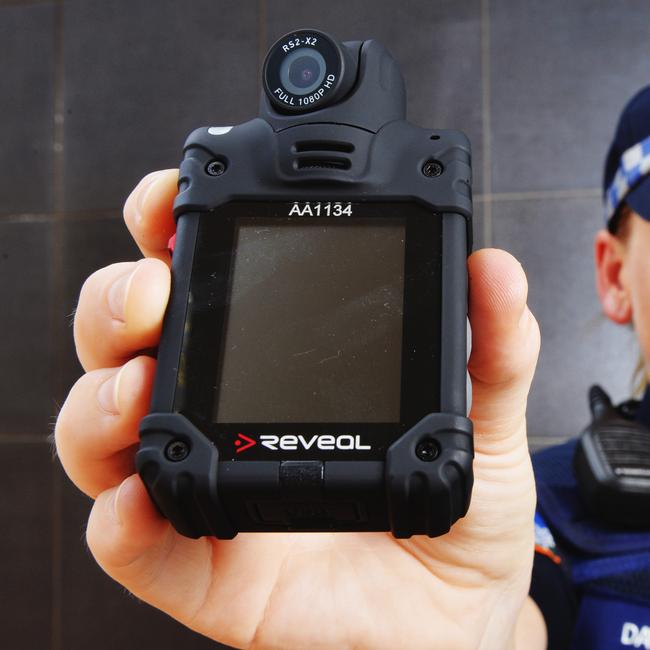NT Ombudsman body cam report calls for NT Police to enforce recording policies
Cops behaving badly have been caught thanks to a tiny camera on their chest. Now the watchdog is calling for more resources to the program.

News
Don't miss out on the headlines from News. Followed categories will be added to My News.
A small black box clinging on a police officer’s chest recorded the moment a Territory man lost consciousness during a 15-second chokehold.
The body-worn camera that recorded this incident is one of 1220 devices that has become general issue among NT Police since they were introduced in late 2014.
Eight years after they appeared on the police beat, the NT Ombudsman has released his investigation into the use of body-worn cameras by Territory cops.
In a report tabled to parliament in March, Peter Shoyer found the introduction of the devices had increased police transparency and accountability, unveiled officer misconduct, while also helping cement convictions against criminals.
Mr Shoyer said while it was an “expensive” program — costing $1.2m a year — it had made a critical impact on policing, courts and the public’s trust in the law.
“The body worn camera program is resource intensive but also highly beneficial for NT police and for officers who are subject to scrutiny,” he said.
Mr Shoyer recommended the program be continued with additional staffing, monitoring and regulation.

The Ombudsman said the body cameras had proven critical to resolving allegations of police brutality, mismanagement or unprofessionalism.
His office has recorded a substantial increase in the number of complaints against police, from nine serious complaints substantiated in 2016-17 to 84 investigations that found improper police conduct in 2021-22.
Mr Shoyer said the footage was key to investigations into excessive force, the improper use of spit hoods and capsicum spray and their interactions as liquor licence inspectors.
But the footage has also been used to clear officers of unfounded allegations, with Mr Shoyer listing six case studies where the videos exonerated officers.
“It is just as likely to provide evidence that police acted reasonably as it is to raise problematic officer conduct behaviour,” Mr Shoyer said.
In the four years to 2021-22, there have been 95 findings against NT Police officers about the failure to use body cameras.

Mr Shoyer said there were cases that suggested a “distinct lack of enthusiasm for body-worn video implementation”, including when cameras were “prematurely switched off”.
“These cases can give rise to complaints that body worn video has been deliberately switched off to avoid detection of poor behaviour or unjustified use of force,” Mr Shoyer said.
Mr Shoyer called on the force to investigate officers who fail to use their cameras, and develop clear policies and processes around replacing lost devices.
“There is always a risk there will be limited utilisation by body-worn video by police if they see adoption as unnecessary or contrary to their interests,” he said.
The police watchdog also highlighted the need for a clear governance structure for the body worn video program, including monitoring and audits to ensure officers use the devices.
He said this needed a commitment from NT Police to provide dedicated internal administrative staff, pointing out that the PFES system administrator left the role in mid-2021 and was not replaced.
In the 55-page report Mr Shoyer also highlighted challenges to the program, including balancing officer’s long shifts with limited batteries and remote connectivity for data downloads.
“The NT is a harsh environment and the nature of policing places a heavy toll on what is relatively sensitive equipment,” Mr Shoyer said.
He said body-worn cameras were not a “cure-all” and thus officers still needed to take contemporaneous written notes.
NT Police executive was provided with a copy of the report and its 12 recommendations and in return provided feedback on the report.
“(The recommendations) have individually been considered by the commissioner and senior executive and accepted in principle,” a police spokesman said.
“The Northern Territory Police force will consider and undertake any necessary feasible steps to give effect to each recommendation and report back to the Ombudsman on those steps.
“The Northern Territory Police force always endeavours to provide the tools and resources to our police officers for the benefit of law enforcement and for community confidence.”
Police Minister Kate Worden said the force had been allocated $1.24m annually for the body-worn camera program.
“The use of body worn cameras is best practice and we support their continued use by NT Police,” Ms Worden said.
More Coverage
Originally published as NT Ombudsman body cam report calls for NT Police to enforce recording policies





